
- 2015 BMW 7-Series
- Interior / Exterior »
The last refresh of the 7-Series, two years ago, brought a new front fascia that adds more interest below–with a long, horizontal lower intake that runs across the nose of the vehicle. The familiar kidney grille was opened up just a bit, with fewer slats, and the front-end surfacing was changed.
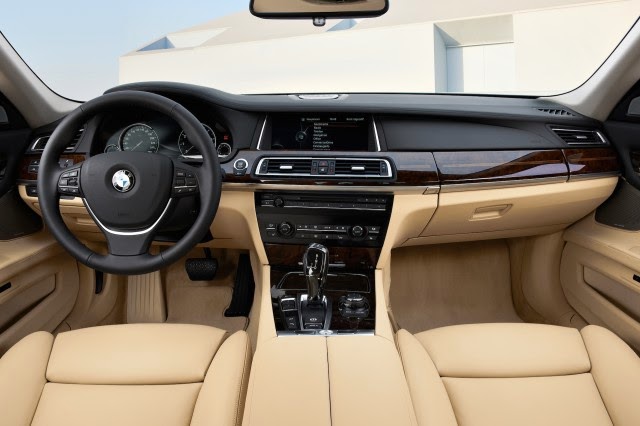
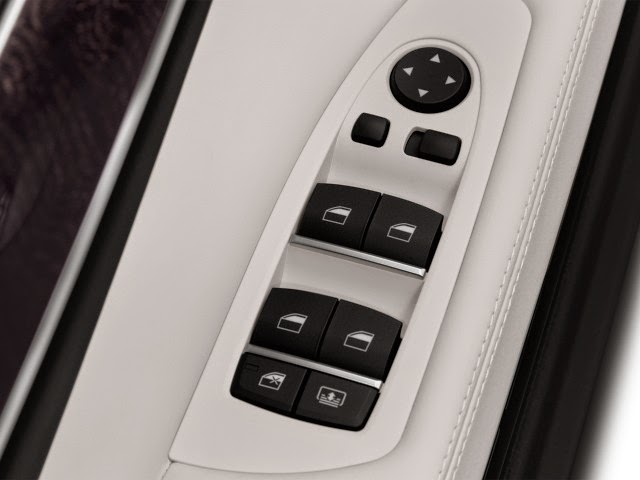
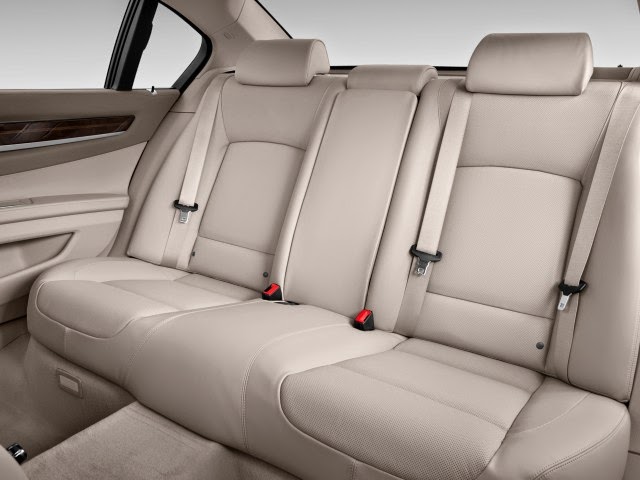
The proportions of the current 7-Series have always been right on the mark. If you even remember the multi-level decklid (the Bangle butt) that got the previous-generation model in trouble with BMW fans, try to forget that. As the current 7-Series is a knockout with a great stance and silhouette.
There’s a lot of elegance in stance and shape (always hard to achieve in a long flagship) of the 2015 7-Series, and a nice kick in its tail. Whether you go for the standard or long-wheelbase versions (adding another 5.5 inches of back-seat legroom), the look is just as attention-getting.
At that time, the taillights also became more finely detailed, while a long chrome strip was added across the bumper.
The design of the cockpit is straightforward — not chaotic and cluttered, as luxury cars can be — with streamlined dash shapes and densely grained wood trim and ceramic-finished knobs. In the center of the dash is a new version of iDrive, which this year adds a touch-pad controller.
With the new reconfigurable info display introduced last year, it’s much better coordinating and intuitive–as well as better-looking. Plus, models at the V-8 level and above now include the leather-wrapped dash.
- Performance »
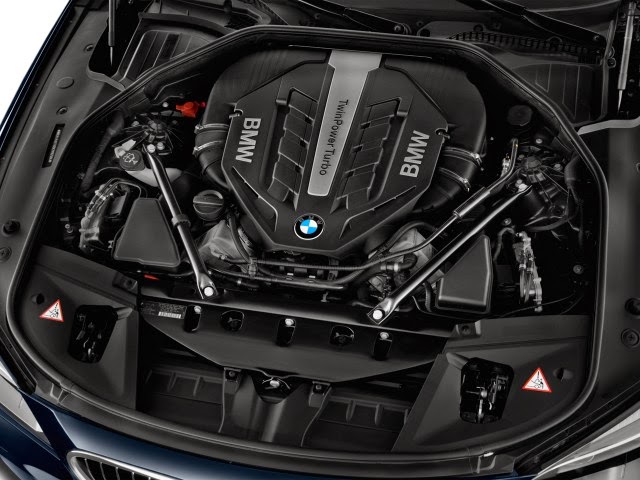
xDrive all-wheel drive is optional on most of the model line–it’s offered in six-cylinder models for the first time this year–and while the system does slightly affect the steering’s feel on center, it does send 20 percent of the torque to the car’s front wheels for better traction.
For those who want performance without as much consumption, there’s the ActiveHybrid 7, which will join the lineup later in the model year and now pairs the six-cylinder engine (not the V-8 anymore) to a system using electric motors and a special lithium-ion battery pack. In general, in BMW’s other models, we’ve found this system lacking in smoothness, while not all that much quicker or more efficient than the normal six-cylinder versions.

All versions get an air suspension, plus Driving Dynamics Control, a system that governs shock firmness, steering heft, transmission shifts, and throttle response–but allows drivers to twiddle with the settings to fit their habits. BMW also offers optional active rear steering, which turns the rear wheels opposite the fronts in some situations to enhance turn-in–and does noticeably speed up the steering response. Across all of these systems the 7-Series would comport itself better than any of the large German luxury liners–if only the steering feel weren’t so artificial.
Electronics are indeed both friend and foe in the 7-Series. Without its battery of electronics, this big sedan might feel like a land yacht, but altogether they dramatically broaden the 7′s driving feel. Even in Normal mode, the 7er is unbelievably nimble for a car so lengthy and heavy. Although we haven’t yet driven the significantly changed V-8 models, our drives of the current-generation 7-Series have always left us awestruck over how planted and stable it feels–whether at Autobahn-style limits or on winding parkways.
While those who appreciate the 7-Series’ sport-sedan pedigree will be able to parse out (and appreciate) the finer differences between these models, across the board you’ll surely find that the 7-Series models accelerate swiftly, with amazing grip and more poise from a vehicle this size. These are for the most part surprisingly satisfying sedans for the driver, although comfort, luxury, and tech are at the top–and that also shows more for some models than others.
New this year is the BMW 740Ld xDrive, which comes with standard all-wheel drive and a 3.0-liter turbocharged inline six-cylinder engine. That engine produces 255 horsepower and 413-lb/ft of torque, good for a 0-60 sprint in 6.1 seconds. This is one of the most efficient ways to pick up a 7-Series, with an EPA rating of 23-mpg city, 31-mpg highway, and combined fuel economy of 26-mpg.
The 2015 BMW 740i and 740Li are the base models in the lineup; they come with a version of BMW’s twin-turbo in-line six, making 315 horsepower and 330 pound-feet of torque. In this form, the 7-Series is probably as quick as you’ll need or expect in a luxury cars–about six seconds to 60 mph–and the smooth, linear character of the powertrain makes it just as enjoyable churning out the torque quietly at low revs or rocketing along on back roads with the revs racing. These models are more than 200 pounds lighter than V-8 versions, so you might find handling more nimble and enjoyable as well.
750i and 750iL models step up to V-8 engines that were all-new last year. The twin-turbo, 4.4-liter V-8 now makes 445 hp and 480 lb-ft of torque, and these models can charge to 60 mph in an automaker-cited 4.7 seconds.
The 760Li might sound like one of the performance leaders of the group–and it is, with 537 hp from its twin-turbo V-12–but you might enjoy the other models over this one if tight, curvy roads are your norm (you do feel the extra weight of the V-12). It weighs a portly 4,800 pounds but can dash to 60 mph in 4.6 seconds to 60 mph.
The true athlete of the 7-Series lineup is the performance-focused Alpina B7, which has a special version of the V-8 underhood that makes 540 horsepower and 538 pound-feet. In addition to that, you get a suspension that’s firmer than any of the other models can manage in Sport mode, as well as bigger brakes, and other enhancements. The 0-60 mph time is just 4.5 seconds here.
Throughout the lineup, you can also get an M Sport package that provides a body kit; 19- or 20-inch wheels; and Active Roll Stabilization, as well as a sport steering wheel.
There are six different powerplants offered in the 2015 BMW 7-Series—740i, 750i, 760i, Active Hybrid 7, the top-performance Alpina B7, and the new diesel-powered 740Ld xDrive. All of these models include standard rear-wheel drive–with exception to the diesel’s standard all-wheel drive–and many offer all-wheel drive, too. While those who appreciate the 7-Series’ sport-sedan pedigree will be able to parse out (and appreciate) the finer differences between these models, across the board you’ll surely find that the 7-Series models accelerate swiftly, with amazing grip and more poise from a vehicle this size. These are for the most part surprisingly satisfying sedans for the driver, although comfort, luxury, and tech are at the top–and that also shows more for some models than others.
The 2015 BMW 740i and 740Li are the base models in the lineup; they come with a version of BMW’s twin-turbo in-line six, making 315 horsepower and 330 pound-feet of torque. These models are more than 200 pounds lighter than V-8 versions, so you might find handling more nimble and enjoyable as well. 750i and 750iL models step up to V-8 engines that were all-new last year. The twin-turbo, 4.4-liter V-8 makes 445 hp and 480 lb-ft of torque, and these models can charge to 60 mph in an automaker-cited 4.7 seconds. The 760Li might sound like one of the performance leaders of the group—and it is, with 537 hp from its twin-turbo V-12–but it’s the portly one in the lineup. The true athlete here is the performance-focused Alpina B7, which has a special version of the V-8 underhood that makes 540 horsepower and 538 pound-feet. In addition to that, you get a suspension that’s firmer than any of the other models can manage in Sport mode, as well as bigger brakes, and other enhancements. The 0-60 mph time is just 4.5 seconds here. The all-new 740Ld xDrive is powered by a 3.0-liter turbo-diesel inline six, capable of producing 255-horsepower and a hefty 413-lb-ft of torque. That motivates the diesel 7er from 0-60 in 6.1 seconds.
All versions get an air suspension, plus Driving Dynamics Control, a system that governs shock firmness, steering heft, transmission shifts, and throttle response–but allows drivers to twiddle with the settings to fit their habits. The only thing we’re left wanting is steering feel that isn’t so artificial.
With 2013′s refresh, the 7-Series got a thinner, more contoured design for the front seats—mostly without extendable thigh bolsters this time. While we still haven’t had the chance to test these out on a long road trip and assure you they’re as good as the seats they replaces, the 7-Series has quite a reputation for keeping trouble-prone backs well supported on the long haul. And we’ll venture to say that the 7-Series remains one of the top picks for tall drivers. Last year’s round of changes also brought redesigned back seats; and you can still choose from bench seats or, with the Luxury Rear Seating Package, individual bucket-style seats with integrated massage and ventilation functions. Ride quality isn’t soft and pillowy, or at all bouncy; rather it’s very well controlled, and about as firm as possible without compromising comfort.

Two years ago, the 7-Series was given a modest makeover in front, and a sharpening of some of its details throughout. But it was inside where the change was more dramatic; new front seats, revised back-seat accommodations, and new trims were only part of it. What meant the most to longtime BMW fans, perhaps, was the all-new set of turbocharged V-8 engines, a revised ActiveHybrid7 model, and eight-speed automatic transmissions across the lineup. Additionally, iDrive got a major upgrade, and the 7-Series got a new generation of entertainment systems. This year, that package is made even more compelling with the addition of the 740Ld xDrive model.
Last year, BMW followed that up with some additional interior and feature upgrades, but the model is still standing well on 2013′s changes. The proportions of the current, fifth-generation 7-Series have always been right on the mark. There’s a nice amount of wedge to the shape (always hard to achieve in a long flagship) of the 2015 7-Series, and a nice kick in its tail. And whether you go with the standard or long-wheelbase versions (where you get another 5.5 inches of rear-seat legroom), the look is just as dramatic. The cockpit is a win as well, as the design is straightforward–not chaotic and cluttered, as luxury cars can often be—with streamlined dash shapes and densely grained wood trim and ceramic-finished knobs.

The refresh also brought new ambient lighting, more sound insulation, and other small changes to the interior make it a more comfortable, engaging place to travel. We still haven’t revisited the 7-Series since then, but we hope to soon update those with proper 2015-model-year impressions.
In the center of the dash is a new version of iDrive, which this year adds a touch-pad controller. With the new reconfigurable information display introduced last year, it’s much better coordinating and intuitive–as well as better-looking. Attention Assist is standard across the lineup, and it monitors the driver’s behavior and displays a coffee cup if it detects an unsafe level of fatigue. Also available on the 7-Series is Enhanced Active Cruise Control system with Stop & Go, which will bring the vehicle to a complete stop if the driver doesn’t react to stopped traffic in time.
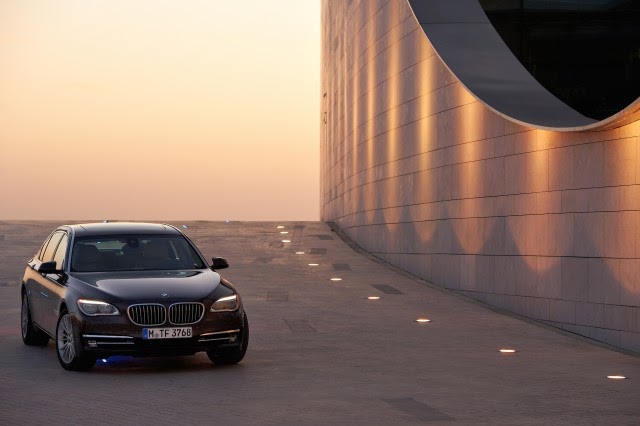
A revised version of BMW’s iDrive interface is included in all 7-Series models. So is a new navigation system adds 3D elements to the display, thanks to a more powerful 1.3-GHz processor and a dedicated 3D graphics card, improving the overall speed of the system as well. And what makes this latest iDrive better is its revised menu system, revised navigation displays, and expanded voice control–including voice-to-text features and other voice editing tools.
An optional rear-seat entertainment package adds an iDrive controller and two 9.2-inch screens, cleverly “floated” behind the rear seats rather than integrated into them. And on the audio front, a new Bang & Olufsen Surround Sound system brings 16 speakers, active digital signal processing, and Dirac Dimensions technology.
For 2015, V-8 models now come with the standard full-LED headlamps and a leather-wrapped dash.
Photo Gallery: BMW
0 Response to "2015 BMW 7-Series"
Post a Comment